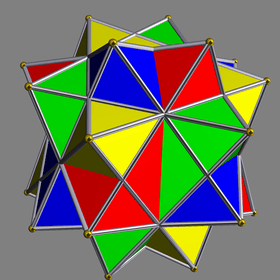Compound of four octahedra with rotational freedom
| Compound of four octahedra with rotational freedom | |
|---|---|
 | |
| Type | Uniform compound |
| Index | UC10 |
| Polyhedra | 4 octahedra |
| Faces | 8+24 triangles |
| Edges | 48 |
| Vertices | 24 |
| Symmetry group | pyritohedral (Th) |
| Subgroup restricting to one constituent | 6-fold improper rotation (S6) |
This uniform polyhedron compound is a symmetric arrangement of 4 octahedra, considered as triangular antiprisms. It can be constructed by superimposing four identical octahedra, and then rotating each by an equal angle θ about a separate axis passing through the centres of two opposite octahedral faces, in such a way as to preserve pyritohedral symmetry.
Superimposing this compound with a second copy, in which the octahedra have been rotated by the same angle θ in the opposite direction, yields the compound of eight octahedra with rotational freedom.
When θ=0, all four octahedra coincide. When θ is 60 degrees, the more symmetric compound of four octahedra (without rotational freedom) arises. In another notable case (pictured), for a certain intermediate value of θ in which 24 of the triangles form coplanar pairs, the compound assumes the form of the compound of five octahedra with one of the octahedra removed.
References
- Skilling, John (1976), "Uniform Compounds of Uniform Polyhedra", Mathematical Proceedings of the Cambridge Philosophical Society, 79 (3): 447–457, doi:10.1017/S0305004100052440, MR 0397554 .